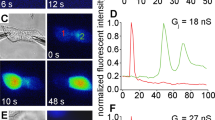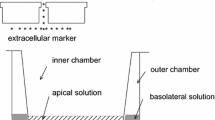Summary
The potassium permeability characteristics of the lens membranes of the amphibianRana pipiens and the cephalopodSepiola atlantica were compared by electrophysiological techniques. Both membrane systems are much more permeable to potassium than sodium and inSepiola, the membranes behave as a pure selective potassium electrode near the normal resting potential. The amphibian lens electrical conductance behaves as an outward rectifier, the properties of which can be altered in the presence of external caesium and rubidium. The effects observed were interpreted in terms of blocking of conductance by the alkali metals.
The resting conductance ofSepiola lens membranes is much greater than that of the frog and it is not voltage-sensitive. When the external potassium is reduced, however, the conductance decreases and the underlying non-linear properties are revealed. Additions of rubidium, caesium and barium to the external medium further reduce the conductance and the rectifying properties are enhanced. Again these effects are interpreted in terms of a blocking of potassium conductance by these ions.
The different potassium permeability properties of the two systems are discussed in terms of the role of potassium in the regulation of lens internal osmolarity.
Similar content being viewed by others
References
Clay JR, Shlesinger MF (1983) Effects of external caesium and rubidium on outward potassium currents in squid axon. Biophys J 42:43–53
Delamere NA, Duncan G (1977) A comparison of ion concentrations, potentials and conductances of amphibian, bovine and cephalopod lenses. J Physiol 272:167–186
Duke-Elder S (1958) System of Ophthalmology, vol 1. Kimpton, London, pp 113–177
Duncan G (1969) The site of the ion restricting membranes in the toad lens. Exp Eye Res 8:406–412
Duncan G (1974) Comparative physiology of lens membranes. In: Davson H, Graham LT (eds). The eye, vol 5. Academic Press, London, pp 357–398
Duncan G, Croghan PC (1969) Mechanisms for the regulation of cell volume with particular reference to the lens. Exp Eye Res 8:421–428
Duncan G, Patmore L, Pynsent PB (1981) The impedance of the amphibian lens. J Physiol 312:17–27
Goldman DE (1943) Potential impedance and rectification in membranes. J Gen Physiol 27:37–60
Hagiwara S, Takahashi K (1974) The anomalous rectification and cation selectivity of the membrane of a starfish egg cell. J Membr Biol 18:61–80
Jacob TJC (1981) Lens cells; conductance, coupling and cataract. PhD thesis, University of East Anglia, Norwich
Jacob TJC (1983) A direct measurement of intracellular free calcium within the lens. Exp Eye Res 36:451–453
Jacob TJC, Duncan G (1980) Osmotic influences on lens membrane characteristics. Exp Eye Res 31:505–512
Jacob TJC, Duncan G (1981a) Electrical coupling between fibre cells in amphibian and cephalopod lenses. Nature 290:704–706
Jacob TJC, Duncan G (1981b) Calcium controls both sodium and potassium permeability of lens membranes. Exp Eye Res 33:85–93
Jacob TJC, Duncan G (1981c) An improved method for investigating the electrical characteristics of the lens. Exp Eye Res 33:463–465
Hille B (1973) Potassium channels in myelinated nerve. J Gen Physiol 61:669–686
Karnovsky MJ (1965) A formaldehyde-glutaraldehyde fixative of high osmolarity for use in electron microscopy. J Cell Biol 27:137
Larsen EH, Rasmussen BE (1982) Chloride channels in toad skin. Philos Trans R Soc 299:413–434
Mathias RT, Rae JL, Eisenberg RS (1979) Electrical properties of structural components of the crystalline lens. Biophys J 25:181–201
Moore JW (1971) Voltage clamp methods. In: Adelman WJ (ed) Biophysics and physiology of excitable Membranes. Van Nostrand, New York, pp 143–167
Patmore L, Duncan G (1980) Voltage-Dependent potassium channels in amphibian lens membranes: evidence from radiotracer and electrical conductance measurements. Exp Eye Res 31:637–650
Patmore L, Duncan G (1980) The physiology of lens membranes. In: Duncan G (ed) Mechanisms of cataract formation in the human lens. Academic Press, London, 193–217
Pickard WF, Lettrin JY, Moore JW, Takata M, Poder J, Bernstein T (1964) Caesium ions do not pass through the membrane of the giant axon. Proc Natl Acad Sci USA 52:1177–1183
Potts WTW, Parry G (1964) Osmotic and ionic regulation in animals. Pergamon, Oxford
Wood DC (1982) Membrane permeabilities determining resting, action and mechanoreceptor potentials inStentor coeruleus. J Comp Physiol 146:537–550
Author information
Authors and Affiliations
Rights and permissions
About this article
Cite this article
Jacob, T.J.C., Duncan, G. A comparative study of the membrane permeability properties of amphibian and cephalopod mollusc lenses. J Comp Physiol B 154, 333–341 (1984). https://doi.org/10.1007/BF00684439
Accepted:
Issue Date:
DOI: https://doi.org/10.1007/BF00684439




